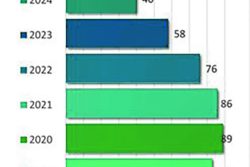VIENNA/OSLO, (Reuters) – The release of two types of radioactive particles in the first 3-4 days of Japan’s nuclear crisis is estimated to have reached 20-50 percent of the amounts from Chernobyl in 10 days, an Austrian expert said today.
The calculations published by Austria’s Central Institute for Meteorology and Geodynamics may add to growing concern in Japan and elsewhere over the contamination of food products such as milk and vegetables in areas near the Japanese reactor site.
On Tuesday, France’s IRSN radiation protection and nuclear safety institute estimated that leaks of radiation from the Fukushima plant crippled by the March 11 earthquake and tsunami represented about 10 percent of those from Chernobyl, the world’s worst nuclear disaster, in 1986.
Astrid Liland, of the Norwegian Radiation Protection Authority, said there was a peak in radiation in Japan a couple of days ago and levels had since decreased.
“Radiation measurements from around Japan today are not very elevated,” she said in Oslo.
In Vienna, the Austrian institute’s Dr Gerhard Wotawa stressed that the two isotopes from Fukushima he had sought to estimate — iodine-131 and caesium-137 — normally make up only one tenth of total radiation.
Unlike the Fukushima crisis, at Chernobyl, in what is now Ukraine, the reactor was blown apart and spewed heavily radioactive fuel core material into the atmosphere.
Another key difference between the two was that most of the radioactivity from the Japanese plant was dispersed across the Pacific, not over land, Wotawa said.
Based on measurements made at monitoring stations in Japan and the United States, Wotawa said the iodine released from Fukushima in the first three-four days was about 20 percent of that released from Chernobyl during a ten-day period.
For Caesium-137, the figure could amount to some 50 percent.
DRIVING FORCE
Wotawa said it was difficult to make day-by-day comparisons with Chernobyl, but he added: “For caesium and iodine … the source terms (amounts released from the two accidents) are not so different.”
He said iodine — linked to cancer if found in high doses — and caesium were both “volatile substances” which escape relatively easily when there are nuclear accidents.
Only minor traces of radiation have been detected in countries outside Japan, but the U.N. nuclear watchdog this week said “high levels of contamination” have been measured around the Fukushima plant, about 250 km north of Tokyo.
Japanese authorities advised parents today not to let infants drink tap water in the capital because of raised radiation levels, and the United States became the first nation to block some food imports from Japan.
Officials from the U.N. nuclear watchdog said a major difference between Fukushima and Chernobyl was in the geographical extent of radioactive contamination.
In Chernobyl, the explosion took place because the nuclear reaction was not halted, unlike in Fukushima, where the reactor was automatically shut down when the earthquake occurred.
“In the case of Chernobyl, with all the graphite that caught fire, it was a driving force to distribute radioactivity high in the air which carried the plume,” Andrew Graham, of the International Atomic Energy Agency (IAEA), said.







